
Schifferstadt, Also known as Scheifferstadt, is the oldest standing house in Frederick, Maryland. Built in 1758, it is one of the nation's finest examples of German-Georgian colonial architecture. It was designated a National Historic Landmark in 2016.
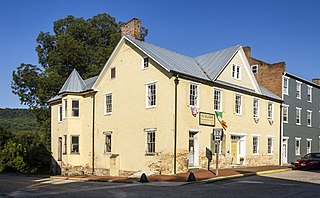
The Burkittsville Historic District comprises the small town of Burkittsville, Maryland. Located at a crossroads in western Frederick County, the town is a consistent collection of early 19th-century Federal style houses mixed with a few Victorian style houses that has remained virtually unchanged since 1900. The town is surrounded on three sides by an open, farmed landscape, and nestles against South Mountain on its western side.

Grahame House, Graham House, Mansion House, Graeme House, or Patuxent Manor, is a historic home located at Lower Marlboro, Calvert County, Maryland. It is an 18th-century original 1+1⁄2-story brick shell laid in Flemish bond with a steeply pitched gable roof. Later alterations have included the purchase and removal of the fine paneling throughout the house to the Henry Francis du Pont Winterthur Museum. Charles Grahame, for whom the home is named, was associated with Frederick Calvert, sixth Lord Baltimore, through Grahame's brother, David Grahame and with Thomas Johnson, first elected Governor of the State of Maryland, through Grahame's son.

Linden is a historic home located at Prince Frederick, Calvert County, Maryland. It is a two-story frame house, conservatively Italianate in style built about 1868, with conservative Colonial Revival additions of about 1907. Behind the house are ten standing outbuildings, seven dating to the 19th century, three of which are of log construction. It is home to the Calvert County Historical Society.
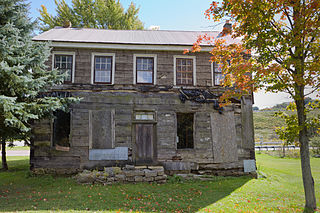
The Fuller-Baker Log House is a historic home located at Grantsville, Garrett County, Maryland, United States. It is a two-story rectangular log home, constructed of log planks about 8 inches (20 cm) thick; some are 14 to 16 inches (36–41 cm) broad and a few are 26 feet long. The house has been restored as an artist's studio and is an example of a log dwelling once common on the Allegheny frontier. Maryland's first governor, Thomas Johnson, owned the property when the house was built in 1815, but it is named for two later residents.

The George Widrick House is a historic home located at Frederick, Frederick County, Maryland, United States. It is a 2+1⁄2-story Federal period brick dwelling, with a 2-story service wing. Outbuildings include a small brick smokehouse and the stone foundation of a barn.

Rose Hill Manor, now known as Rose Hill Manor Park & Children's Museum, is a historic home located at Frederick, Frederick County, Maryland. It is a 2+1⁄2-story brick house. A notable feature is the large two-story pedimented portico supported by fluted Doric columns on the first floor and Ionic columns on the balustraded second floor. It was the retirement home of Thomas Johnson (1732–1819), the first elected governor of the State of Maryland and Associate Justice of the United States Supreme Court. It was built in the mid-1790s by his daughter and son-in-law.
The Henry Nelson House is a historic home and farm complex located at New Market, Frederick County, Maryland, United States. It is a 2+1⁄2-story, coursed stone rubble house built about 1800, with a gable roof, and a corbeled brick cornice. Outbuildings include a barn, log springhouse, and a small log house.
The Pearre-Metcalfe House is a historic home located at New Windsor, Frederick County, Maryland, United States. It is a brick Greek Revival style farmhouse, built about 1859. There is a small, brick springhouse with corbeled brick cornice and tin roof on the property.
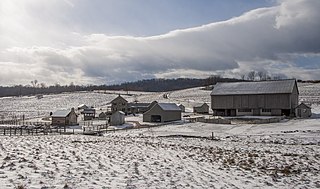
Peter of P. Grossnickel Farm is a historic home and farm complex located at Myersville, Maryland, Frederick County. It consists of a mid-19th-century, Greek Revival farmhouse and 13 related buildings and structures. The house is a 2+1⁄2-story stone center-passage house on a limestone foundation, with a 1+1⁄2-story kitchen wing and 18-inch-thick (460 mm) walls. The house was built between 1840 and 1850. Also on the property is an 1881 tenant house with corresponding barn, spring house, and washhouse / privy; an 1884–1897 bank barn; a pre-1830 granary; a 19th-century wood shed; late-19th-century hog pen / chicken house; a pre-1830 beehive oven; a late-19th-century smokehouse; a spring house with a Late Victorian cottage addition; and early-20th-century concrete block milk house; and a log summer kitchen of unknown date. The Grossnickel family was a German American family who were instrumental in the establishment of the Grossnickel Church of the Brethren.
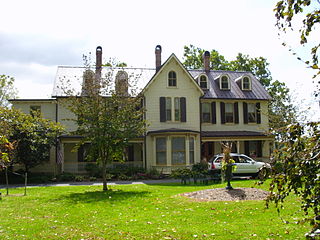
The Highland Lodge, also known as Pequea, is a historic home and resort building complex located at Frederick, Frederick County, Maryland, United States. It consists of a large Victorian period frame house centered at the end of a circular driveway, and its complement of outbuildings. The house is large and rambling and considered eclectic in style with a prominent central projecting gable. The property includes a frame stable and carriage house, now garages; a small frame barn; a small log dwelling moved to the property in the early 20th century; a frame summer kitchen and a frame secondary dwelling. It was developed originally in 1881 as a summer home for John H. Williams, a wealthy and influential Frederick attorney and banker.

The Woodsboro and Frederick Turnpike Company Tollhouse is a historic toll house located at Walkersville, Frederick County, Maryland, United States. It is a two-story brick structure over a stone foundation, with a small interior end chimney at each gable end. It was used as a tollhouse by the Woodsboro and Frederick Turnpike Company.
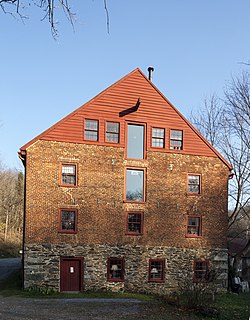
Lewis Mill Complex is a historic grist mill complex located at Jefferson, Frederick County, Maryland. The complex consists of seven standing structures, a house foundation, and the remains of an earlier millrace. It centers on an early 19th-century three-story brick mill structure with a gabled roof. The mill complex served German immigrant farmers in Middletown Valley between 1810 and the 1920s. It was rehabilitated in 1979-1980 for use as a pottery shop. Also in the complex are a stuccoed log house and log springhouse built about; a frame wagon shed and corn crib structure and frame barn dating from the late 19th century; and early 20th century cattle shelter and a frame garage.

The Emmitsburg Historic District is a national historic district in Emmitsburg, Frederick County, Maryland. The district is predominantly residential and includes most of the older area of the town extending along Main Street and Seton Avenue. Also included are several commercial buildings and churches interspersed among the dwellings. The buildings are primarily two-story sided log or brick, dating from the late 18th to the mid 19th centuries. Some later 19th century buildings in this area include some large Italianate-influenced buildings forming the northeast and southeast corners of the main square; an area destroyed by fire in 1863. Settlement began in the region during the 1730s, bringing Protestant Germans and Scotch-Irish from Pennsylvania, as well as English Catholics from Tidewater Maryland.

The New Market Historic District is a national historic district in New Market, Frederick County, Maryland. The district encompasses the town located along what was originally the National Pike. About 90 percent of the buildings in the historic district date from the 19th century and include Federal-style buildings and Greek Revival buildings, with a number of Victorian buildings, a larger example being the Ramsburg House.

The Bowman House is a historic log house located at 323 North Main Street in Boonsboro, Maryland, and is locally significant as a typical example of those built in the area in the early 19th century.

The Jacob Highbarger House was built circa 1832 in Sharpsburg, Maryland, United States. The Greek Revival-influenced house is a late example of limestone construction in the Cumberland Valley of Maryland, with an attached log workshop. The log structure is an unusual example of corner-post log construction with diagonal bracing.

Geeting Farm is a historic home located at Keedysville, Washington County, Maryland, United States. It is a two-story, five-bay log dwelling resting on low fieldstone foundations, with a one-story, three-bay stone addition. Numerous sheds and outbuildings are located near the house. The house was built by George Adam Geeting [1741-1812], who settled on this land near Little Antietam Creek after immigrating to the English Colony of Maryland in 1759 from his native Prussia. Geeting farmed his land and taught in a log schoolhouse nearby which became a regular preaching appointment for services held by Rev. Philip William Otterbein, one of the founding leaders of the United Brethren in Christ, the first denomination organized in the United States of America. In the mid-1770s, Geeting erected a meetinghouse which later became known as Mount Hebron Church, the first structure built expressly for services of the future United Brethren in Christ denomination. Salem United Methodist Church in Keedysville is the successor to the Mount Hebron Church and Geeting Meetinghouse. Getting himself was ordained a minister of the German Reformed Church in 1788 and traveled extensively through Western Maryland, Virginia, and Pennsylvania as an itinerant preacher. On September 25, 1800, George Adam Geeting attended the first conference of the United Brethren in Christ at the home of Peter Kemp near Frederick, Maryland. It was at this conference that the United Brethren in Christ was formally organized as a denomination and took its name. Geeting continued serving as a minister for the new church, acted as secretary of the denominational conference, and served as a bishop of the United Brethren in Christ briefly in 1812 before his death.

Creagerstown is an unincorporated community in Frederick County, Maryland, United States. It is playfully known by its residents as "4 miles from everywhere" because of its situation at 4 miles (6.4 km) from Thurmont, Woodsboro, Rocky Ridge, and Lewistown.

Oakdale is a historic plantation located in Daisy, (Woodbine) Howard County, Maryland, former home of Maryland Governor Edwin Warfield.





















